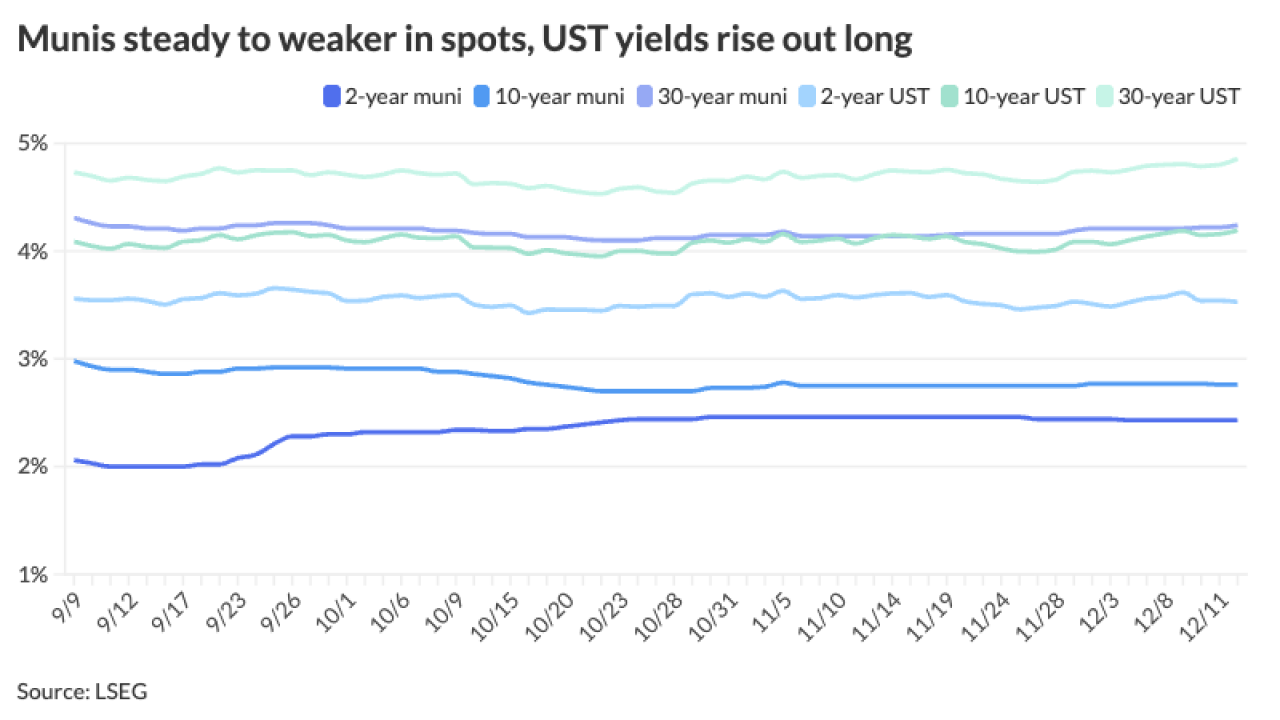Municipals were steady to weaker in spots, as U.S. Treasuries cheapened and equities ended up.
The two-year muni-UST ratio Thursday was at 70%, the five-year at 66%, the 10-year at 68% and the 30-year at 90%, according to Municipal Market Data's 3 p.m. EDT read. ICE Data Services had the two-year at 70%, the five-year at 67%, the 10-year at 69% and the 30-year at 90% at a 4 p.m. read.
There continues to be strong supply, with $17.9 billion brought to market this week, helping 2025 become another record year, said Jennifer Johnston, director of municipal bonds research at Franklin Templeton.
That may be a spike following Fed rate cuts as some issuers who may have been waiting on the sidelines take advantage of current rates, she said.
"That's part of what's driving demand right now, and part of the reason why we're seeing flows turn around, which is great, given the size of the calendar that we're expecting," she said.
Positive flows are returning to the muni market, mutual funds, along with exchange-traded funds, Johnston said.
There is demand out there, and that demand will continue. There is money coming in rather than reinvestment dollars, she said.
The market has been able to digest all these deals, Johnston said.
"We're not going to be having huge reinvestment months over the next few months, not until the beginning of the year. So we need this flow [of deals] to keep up with demand, and we expect that to continue," she said.
Issuance will "quiet down" as the holiday season approaches, but demand will keep pace, according to Johnston.
The secondary market has been a bit quieter in the last several days, with fewer bid-wanteds out there due to little selling pressure right now, she said.
"Everything is doing fine; it's just slowed a little bit. Anything that's been out there has done great compared to eval," Johnston said.
Compared to the start of the year, munis are in a stronger position, said James Welch, municipal portfolio manager at Principal Asset Management.
"Policy uncertainty has receded, supply pressures are easing, and demand has broadened across both institutional and retail channels," he said. "The asset class now benefits from healthier technicals, normalized valuations, and a renewed role as an income-rich, defensive allocation heading into 2026."
While risks remain, "particularly the possibility of stickier inflation delaying Fed easing … municipals now present one of the most constructive setups in recent years," Welch said.
Earlier headwinds, such as worries over the elimination of the tax exemption, record issuance and delayed Fed cuts, have subsided, he said.
Supply, though still elevated, is moderating, and with policy risk "off the table," valuations have reset to more attractive levels, he said.
Overall, the market's technical position has "meaningfully improved" and demand is strong, Welch said.
Absolute yields remain elevated, and on a tax-equivalent basis, munis offer "some of the most attractive income opportunities across fixed income," he said, noting "these yields have drawn nontraditional buyers back into the market … adding to the retail base already searching for tax-advantaged income."
In the primary market, Morgan Stanley priced for Oklahoma City Water Utilities Trust (Aaa/AAA//) $186.91 million of utility system revenue refunding and improvement bonds, with 5s of 7/2028 at 2.48%, 5s of 2030 at 2.49%, 5s of 2035 at 2.86%, 5s of 2040 at 3.37%, 5s of 2045 at 3.96%, 5s of 2050 at 4.22% and 5s of 2055 at 4.31%, callable 7/1/2034.
Wells Fargo priced for Charlotte, North Carolina, (Aaa/AAA/AAA/) $177.4 million of GO refunding bonds, Series 2025B, with 5s of 7/2026 at 2.61%, 5s of 2030 at 2.42%, 5s of 2035 at 2.74%, 5s of 2040 at 3.32% and 4s of 2045 at 4.09%, callable 7/1/2035.
Jefferies priced for the Village Community Development District No. 16, Florida, $127 million of nonrated special assessment revenue bonds, with 3.55s of 5/2030 at par, 4s of 2035 at 3.93%, 4.5s of 2040 at 4.40%, 4.875s of 2045 at par and 5.125s of 2056 at par, callable 5/1/2033.
Morgan Stanley priced for Oregon (Aa1/AA+/AA+/) $106.88 million of GOs, 2025 Series K, with 5s of 11/2026 at 2.57%, 5s of 2030 at 2.46%, 5s of 2035 at 2.86%, 5s of 2040 at 3.39%, 5s of 2045 at 3.93% and 5s of 2050 at 4.15%, callable 11/1/2035.
In the competitive market, Suffolk County, New York, (/AA-/AA-/) sold $188.735 million of public improvement serial bonds, Series 2025A, to Jefferies, with 5s of 11/2026 at 2.50%, 5s of 2030 at 2.34%, 4s of 2035 at 2.71% and 4s of 2039 at 3.20%, callable 11/1/2033.
Henrico County, Virginia, (Aaa/AAA/AAA/AAA/) sold $125 million of water and sewer system revenue bonds, Series 2025D, to BofA Securities, with 5s of 5/2029 at 2.37%, 5s of 2030 at 2.38%, 5s of 2035 at 2.75%, 4s of 2040 at 3.49%, 4s of 2044 at 4.02% and 4.25s of 2051 at 4.34%, callable 5/1/2035.
Fund flows
Investors added $1.123 billion to municipal bond mutual funds in the week ended Wednesday, following $678.1 million of inflows the prior week, according to LSEG Lipper data.
High-yield funds saw inflows of $179.2 million compared to inflows of $15.1 million the previous week.
Tax-exempt municipal money market funds saw outflows of $153.9 million for the week ending Oct. 21, bringing total assets to $140.437 billion, according to the Money Fund Report, a weekly publication of EPFR.
The average seven-day simple yield for all tax-free and municipal money-market funds fell to 2.02%.
Taxable money-fund assets saw $43.573 billion added, bringing the total to $7.225 trillion.
The average seven-day simple yield was at 3.80%.
The SIFMA Swap Index was at 2.50% on Wednesday compared to the previous week's 2.31%.
AAA scales
MMD's scale was cut two basis points six years and in: 2.53% (+2) in 2026 and 2.42% (+2) in 2027. The five-year was 2.36% (+2), the 10-year was 2.70% (unch) and the 30-year was 4.10% (unch) at 3 p.m.
The ICE AAA yield curve was cut up to three basis points: 2.49% (+3) in 2026 and 2.41% (+3) in 2027. The five-year was at 2.38% (+1), the 10-year was at 2.74% (unch) and the 30-year was at 4.08% (unch) at 3 p.m.
The S&P Global Market Intelligence municipal curve was cut on the front end: The one-year was at 2.51% (+3) in 2025 and 2.43% (+3) in 2026. The five-year was at 2.36% (+2), the 10-year was at 2.71% (unch) and the 30-year yield was at 4.08% (unch) at 3 p.m.
Bloomberg BVAL was cut seven years and in: 2.48% (+2) in 2025 and 2.42% (+2) in 2026. The five-year at 2.34% (+1), the 10-year at 2.70% (unch) and the 30-year at 4.04% (unch) at 4 p.m.
Treasuries were weaker.
The two-year UST was yielding 3.487% (+4), the three-year was at 3.493% (+5), the five-year at 3.605% (+5), the 10-year at 4% (+5), the 20-year at 4.553% (+5) and the 30-year at 4.582% (+5) near the close.





